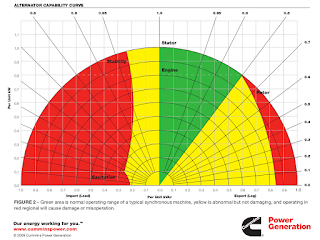
Generator Ratings
When evaluating generator sets for parallel operation, ratings are important because the rating directly affects the efficiency and effectiveness of the selected generator set based on the application. It is especially important to understand the specific application, as this will help in selecting the proper rating. Specifically, the following factors should be taken into consideration:-
* Average load factor
* Maximum required load
* Typical load variation
* Annual run time per genset
ISO 8528 (https://www.iso.org/obp/ui/#iso:std:iso:8528:-5:ed-3:v1:en), for example, should be considered a minimum standard for all generator set ratings. If the manufacturer determines that a product is capable of higher performance than that of the ISO definition, the manufacturer's rating should be used. Definitions relevant to this discussion are power factor, standby power rating, prime power rating, and continuous power rating.
Power Factor: The standard power factor for a 3-phase generator is usually around 0.8.
Standby Power Rating: The generator set is capable of providing emergency power at times when no other source is available. ISO-8528-1 limits the 24-hour average load factor to 70% of the emergency nameplate rating. No overload capacity is available for the standby or continuous-power-rated generators. The ISO standard gives no limit to run time in the event of a utility power outage. However, manufacturers have limits on their generator run time typically in the range of 200 to 500 hours for an entire year. Standby generators typically operate around 50 hours/year with maximum expected usage of 200 hours per year.

Prime Power Rating: Generator sets rated for prime power are designed for supplying electric power in lieu of commercially purchased power from a utility. These include applications like rental generator sets supplying power for temporary use as well as applications that are typically remote from a utility grid, such as wilderness outposts, remote mining, and petroleum exploration operations. ISO limits the 24-hour average load factor to 70% of the prime rating nameplate. Prime-rated power is capable of providing the power for an unlimited time period to a varying load. Overload is also allowed but only at 10% of the rated value, which is permitted to only once in 12 hours.

Continuous Power Rating: With a continuous power rating, the generator can again provide a power supply for an unlimited period-but only to a non-varying load. But the average output power comes out to be between 70% to 100% of the rated power output. The load should be "relatively steady," which means that there should be no significant variations in it; otherwise, the prime power rating could be a better option to consider. A continuous-rated generator usually does not have any overload capability.
About us
Strategic Media Asia (SMA) is one of the approved CPD course providers of the Chartered Institution of Building Services Engineers (CIBSE) UK. The team exists to provide an interactive environment and opportunities for members of ICT industry and facilities' engineers to exchange professional views and experience.
SMA connects IT, Facilities and Design. For the other design considerations, please visit
(1) Site Selection,
(2) Space Planning,
(3) Cooling,
(4) Redundancy,
(5) Fire Suppression,
(6) Meet Me Rooms,
(7) UPS Selection,
(8) Raised Floor,
(9) Code & Standards,
(10) Transformers and Harmonic Distortion,
(11) Multi-mode UPS Systems,
(12) Electrical Rooms,
(13) Generator Systems, etc.
All topics focus on key components and provide technical advice and recommendations for designing a data center and critical facilities.


No comments:
Post a Comment
Note: Only a member of this blog may post a comment.